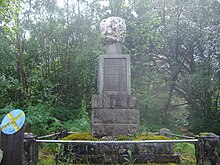James of the Glen
| James Stewart of the Glen | |
|---|---|

Seamus a'Ghlinne memorial cairn
|
|
| Born | c. 1698 |
| Died | November 8, 1752 |
| Cause of death | Hanging |
| Nationality | Scotsman |
| Other names | James of the Glens Seamus a’ Ghlinne James Stewart of Acharn |
| Criminal charge | Accessory to Murder |
| Criminal penalty | Capital punishment |
James Stewart of the Glen (Gaelic: Seumas a' Ghlinne; c. 1698 - November 8, 1752)was a Scotsman famous for being wrongfully accused and hanged as an accessory to the Appin Murder, in which Colin Roy Campbell (a.k.a. "The Red Fox"), a government factor of estates forfeited by pro-Jacobite clans following the Rising of 1745, was killed.
On November 8, 1752, as he climbed the gibbet, Seamus a' Ghlinne prayed:
"False witnesses rose; to my charge things I not knew they laid. They, to the spoiling of my soul, me ill for good repaid." ~Psalm 35
While he was not afraid to die for his convictions, he lamented that people of the ages may think him capable of a horrid and barbarous murder.
After his execution, James' body was left hanging at the south end of the Ballachulish Ferry for eighteen months as a warning to other clans with rebellious intentions. Over those months, Stewart's body was beaten and battered by winds and rain. As it eventually deteriorated, the skeletal remains were held together with chains and wire.
James of the Glen makes a cameo appearance in the novel Kidnapped by Robert Louis Stevenson. Several accounts of the Appin Murder have published since 1752, the most recent being Culloden and the Last Clansman (2001) by Dr James Hunter. An editorial review of this novel follows:
In May 1752 in the Scottish Highlands, a rider is shot dead by a hidden gunman. The murdered man is Colin Campbell, a government agent heading for nearby Duror where he plans to evict Duror's farming tenants and replace them with his relatives. Colin Campbell's killer escapes. But Britain's rulers insist that this challenge to their authority must be paid for with a hanging. The sacrificial victim is James Stewart who, from his Duror home, has been organizing resistance to the murdered man's evictions. Stewart is a veteran of the Highland uprising which culminated in the Battle of Culloden in April 1746. Back in Duror he saw home after home torched by troops sent to bring the Highlanders to heel. But Stewart, refusing to knuckle under, takes on the officials —among them Colin Campbell— who are trying to impose British rule on the Highlands. Colin Campbell's killing rocked 18th-century Britain and became the inspiration for Robert Louis Stevenson's classic novel, Kidnapped. And ever since the fatal shot was fired, people have argued about who actually pulled the trigger.
...
Wikipedia
